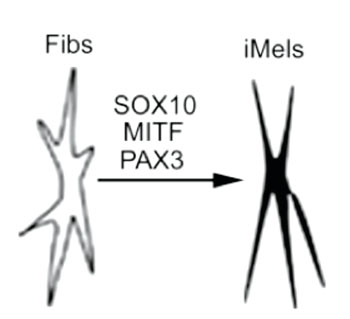Direct Reprogramming of Fibroblasts into Melanocytes Avoids Cancer Threat
By LabMedica International staff writers
Posted on 30 Dec 2014
A team of cell biologists has successfully induced fibroblasts to convert to functional melanocytes (melanin-producing skin cells) without going through a preliminary pluripotent stage.Posted on 30 Dec 2014
Direct reprogramming provides a fundamentally new approach for the manufacture of patient-specific cells that greatly reduces the danger of inadvertently generating tumors. In the current study, investigators at the University of Pennsylvania (Philadelphia, USA) and their colleagues devised a method for directly reprogramming fibroblasts into functional melanocytes.

Image: Dermal fibroblasts are directly reprogrammed to pigmented melanocytes by three transcription factors (SOX10, MITF, and PAX3) (Photo courtesy of the University of Pennsylvania).
The first step was to identify 10 specific cell transcription factors linked to melanocyte development. Transcription factor screening assays revealed that three transcription factors - SOX10 (sex determining region Y-box 10), MITF (microphthalmia-associated transcription factor), and PAX3 (paired box 3) - out of those 10 were sufficient to induce fibroblasts to transform into melanocytes.
Results published in the December 16, 2014, online edition of the journal Nature Communications revealed that induced melanocytes (iMels) produced by this technique activated melanocyte-specific networks, expressed components of the pigment production and delivery system, and produced melanosomes. Human iMels properly integrated into the dermal-epidermal junction and produced and delivered melanin pigment to surrounding keratinocytes in a three-dimensional organotypic skin reconstruct. Furthermore, human iMels generated pigmented epidermis and hair follicles in skin reconstitution assays in vivo.
"We did a huge amount of work," said senior author Dr. Xiaowei Xu, associate professor of pathology and laboratory medicine at the University of Pennsylvania. "We eliminated all the combinations of the other transcription factors and found that these three are essential. Through direct reprogramming, we do not have to go through the pluripotent stem cell stage, but directly convert fibroblasts to melanocytes. So these cells do not have tumorigenicity. By generating melanocytes from the fibroblasts of melanoma patients, we can screen not only to find why these patients easily develop melanoma, but possibly use their cells to screen for small compounds that can prevent melanoma from happening."
Related Links:
University of Pennsylvania










 (3) (1).png)


